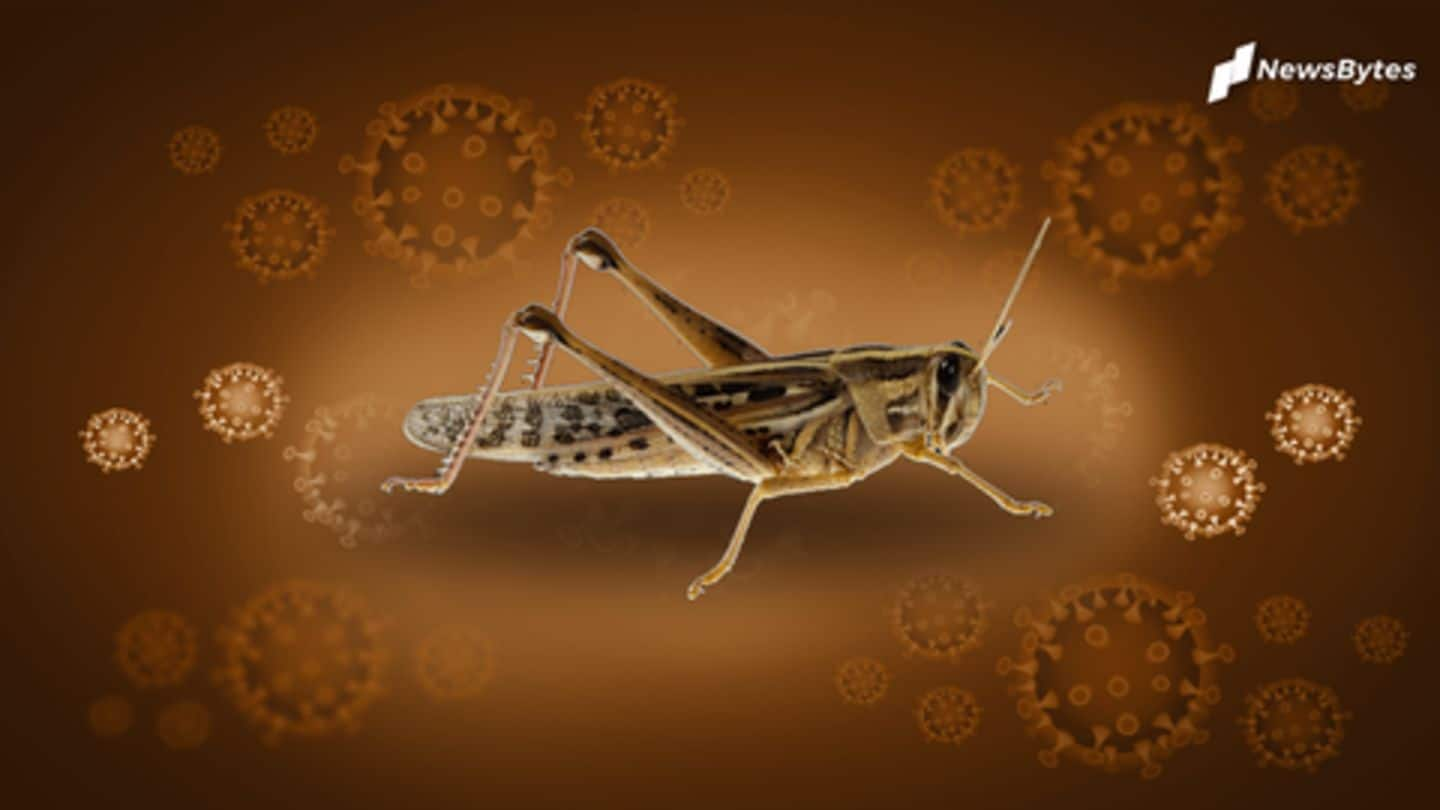
Double whammy: Amid coronavirus crisis, locusts destroy crops
What's the story
Just as India battles coronavirus pandemic, it is faced with another problem — locusts — who are destroying crops and entering residential areas.
The locust attack has been most devastating for Rajasthan, with states like Uttar Pradesh and Madhya Pradesh also being affected. They have also entered the eastern parts of Maharashtra.
Experts said these locusts have to be eliminated before it's too late.
Insects
What are locusts? Why are they harmful for crops?
Locusts are just like grasshoppers, only more lethal. Their two big hind legs allow them to hop on crops and destroy vegetation in a matter of hours.
Usually, they have solitary lives but come together in millions during dry spells. They quickly travel thousands of miles, feeding on plants on the way.
Each insect can eat as much as it weighs.
Origin
Where do these locusts come from?
After originating in East Africa and Sudan, these insects travel across Saudi Arabia and Iran to reach Pakistan, India.
Scientists believe a "longer-than-usual" monsoon and frequent cyclones triggered this outbreak.
Keith Cressman, locust forecasting officer at Food and Agriculture Organisation (FAO) said, "The current locust outbreak is the biggest in 25 years in Ethiopia and Somalia, 26 years in India, 70 years in Kenya."
What happened
Even residential areas of Jaipur weren't immune to them
In Rajasthan, 16 of the 33 districts are affected and the state's Kharif crop is at risk.
And for the first time since the early 1990s, these locusts went all the way to Jaipur, even entering residential areas.
BR Karwa, deputy director at the Agriculture Department, said a plethora of these insects entered localities like Vidhyadhar Nagar, Shastri Nagar. They then went towards Dausa.
Quote
They entered Jaipur because crops are harvested, suggested Karwa
"We believe this time the swarms came all the way to Jaipur because the locusts couldn't find any crop to consume — most of the crop has already been harvested. This was the first instance since 1993 that locust swarms entered the city," he said.
Details
For MP and UP, this is an uncharted territory
Meanwhile, dealing with the locust problem is new for UP and MP. This week, locusts entered Chief Minister Shivraj Singh Chouhan's constituency Budhni.
Sugarcane commissioner, Sanjay R Bhoosreddy, who is handling the problem in Uttar Pradesh, said data of last major locust attack is unavailable.
Crops were damaged in Jhansi, Lalitpur, and Hamirpur districts, and areas like Agra, Aligarh, and Mathura are under threat.
Solution
Farmers were asked to generate sound to scare them away
PrayAgraj District Agriculture Officer Ashwani Kumar Singh said farmers were told that beating tin drum or plates will scare away the insects. Cops were asked to blow sirens.
"Besides, they (farmers) are also being advised to spray pesticides on their crops to protect them from locusts," he said.
204 tractors, complete with chemical sprays, were deployed in Agra to deal with the problem.
Madhya Pradesh
Farmers are lighting bonfires in Madhya Pradesh
In Madhya Pradesh, locusts are being tracked and being sprayed with chemicals, informed Ajeet Kesari, the principal secretary of the agriculture department.
Farmers of Hoshangabad, Raisen, Sehore, Sagar, Chhatarpur, Harda, generated sound, burst crackers, and lit bonfires to keep locusts away. Pesticides were also given to farmers.
Madhya Pradesh Agriculture Minister Kamal Patel said farmers will be compensated after assessing the damage.
Threat
Ministry said locusts have to be killed before monsoons
The Locust Warning Organization which comes under the Union Agriculture Ministry said more needs to be done before the arrival of monsoons.
"If we are not able to control the sub-adults (the swarms that are already in MP and Rajasthan) they will grow into adults come back to the summer breeding sites along the Indo-Pak border in the desert," said LWO's KL Gurjar.
Prediction
Locusts could enter India directly from Horn of Africa
It's expected that more groups will be formed as vegetation dries out. These locusts will then move towards summer breeding areas and good rainfall will enable the egg-laying process.
"There is also a possibility that they enter India directly from the Horn of Africa in July by crossing the sea with the help of winds. The situation is being continuously monitored," Gurjar added.
Steps
Pesticides are being sprayed in the morning
Notably, 50 people are deployed on the ground by LWO. Drones are being used to spray Malathion 96, an organophosphate insecticide, on non-cropped areas. On fertile areas, chlorpyrifos is being sprayed.
These locusts lay eggs on moist sandy or sand/clay soil.
"If they are not controlled in hopper stage, then they turn into swarms that will again pose a challenge for us," Gurjar said.